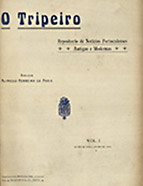

................................
Over the years, and particularly with the celebration of its fiftieth anniversary in 1958, O Tripeiro continued to publish articles and historical documents from both public and private collections of greater historical credibility than in earlier series. These serious historiographical studies were interspersed with cultural and recreational notes. Dependent almost exclusively on its sales revenue, in a parochial and patriotic endeavour often shaped by political and professional interests, O Tripeiro continued to support the ideological and nationalist policies of the Estado Novo . It emphasised the propaganda of history and ethnography as a means of affirming Portuguese identity and values. Sections such as Figuras portuenses [Figures from Porto] Achegas arqueológicas e iconográficas [Archaeological and Iconographic Additions] Arte e dos artistas [Art and Artists] O que deseja saber acerca do Porto? [What Do You Want to Know About Porto?] and Comunicações aos leitores [Communications to Readers] followed in the same vein as their predecessors. Alongside these in-depth articles, often featured on the front pages, explored a variety of themes and subjects with a common Porto or northern focus, including issues related to material heritage, literary figures, notable personalities, public and private institutions, topographical and toponymic evolution, city events, the press, and impressions of foreign visitors. While some articles aimed to challenge old historiographical myths and propose new hypotheses based on unpublished documents and recent bibliography, they still largely adhered to positivist and historicist perspectives, often focused on episodes from the mediaeval period to the 19th century. The magazine did not overlook the grand municipal and national commemorations promoted by the central government. The contacts and prestige of the editorial board, led by Magalhães Basto and António Cruz, were instrumental in shaping these directions and opening the journal to new scientific exchanges. The Centro de Estudos Humanísticos [Centre for Humanistic Studies], associated with the University of Porto, where both were lecturers, facilitated collaborations with academics from all four Portuguese universities, as well as exchanges with the University of São Paulo. Among the most active contributors to this series were board members such as Horário Marçal, L. Nunes da Ponte, Flávio Gonçalves, J. A. Pinto Ferreira, M. Cruz Malpique, Hernâni Cidade, Jorge de Sena, Alfredo Ataíde, Mendes Corrêa, Maria Barjona de Freitas, and others, along with a small number of foreign authors including Antonio Castilo de Lucas, Arnold Hawkins, and Lorenzo di Poppa.
This work is financed by national funds through FCT - Foundation for Science and Technology, I.P, in the scope of the projects UIDB/04311/2020 and UIDP/04311/2020.
